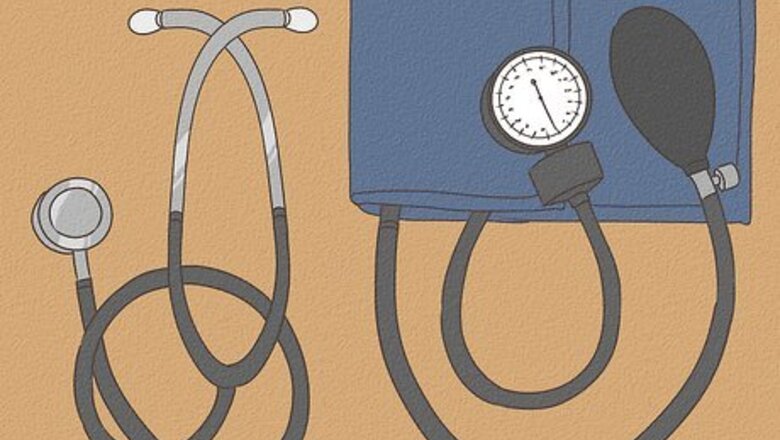
views
Equipment Setup
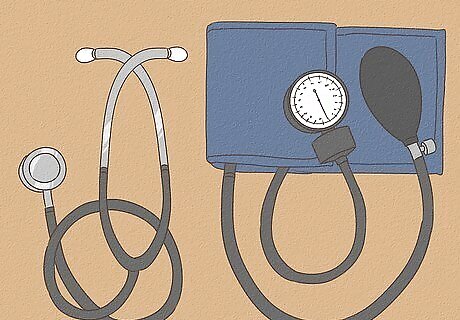
Sit down and open the blood pressure testing kit. Sit down at a table or desk where you can easily set up the necessary equipment. Remove the cuff, stethoscope, pressure gauge, and bulb from the kit, taking care to untangle the various tubes.

Raise your arm to heart level. Elevate your arm so that when you bend your elbow, your elbow is parallel to your heart. This ensures that you will not get either an overestimated or underestimated reading on your blood pressure. It is also important that your arm is supported during the reading, so make sure to rest your elbow on a stable surface.
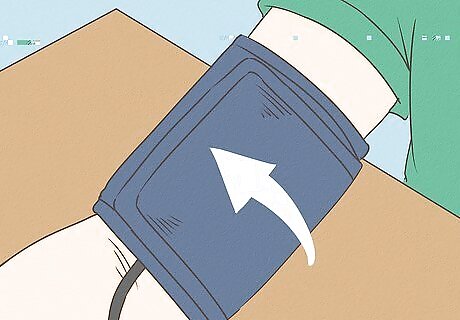
Wrap the cuff around your upper arm. Most cuffs have Velcro, making it easy to secure the cuff in place. If your shirt has long or thick sleeves, roll them up first, as you can only put the cuff over very thin clothing. The bottom edge of the cuff should be about an inch above the elbow. Some experts recommend you use your left arm; others suggest you test both arms. But while you're first adjusting to self-testing, use the left arm if you're right-handed, or vice versa.
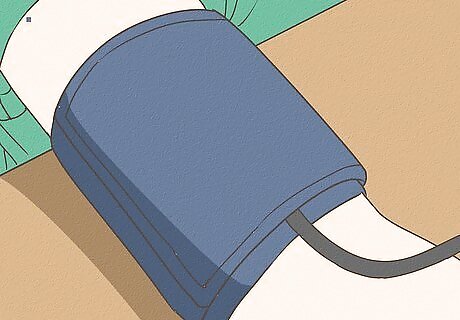
Make sure the cuff is snug, but not too tight. If the cuff is too loose, the cuff will not compress the artery correctly, giving you an inaccurately low blood pressure reading. If the cuff is too tight, it will create what is known as "cuff hypertension" and give you an inaccurately high reading. Cuff hypertension can also occur if the cuff is too narrow or too short relative to your arm.

Place the wide head of the stethoscope on your arm. The head of the stethoscope (also known as the diaphragm) should be placed flat against the skin on the inside of your arm. The edge of the diaphragm should be just beneath the cuff, positioned over the brachial artery. Gently put the earpieces of the stethoscope in your ears. Do not hold the head of the stethoscope with your thumb — your thumb has its own pulse and this will confuse you while you try to obtain a reading. A good method is to hold the head of the stethoscope in place with your index and middle fingers. This way, you should not hear a thumping sound until you have begun to inflate the cuff.
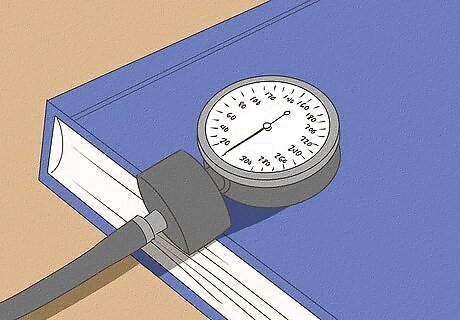
Clip the pressure gauge to a stable surface. If the pressure gauge is clipped to the cuff, unclip it and attach it to something sturdy instead, such as a hardcover book. That way, you can place it in front of you on the table, making it easier to watch. It's important to keep the gauge anchored and stable. Make sure there is adequate light and you can see the needle and pressure markings well before you begin to test. Sometimes the gauge is attached to the rubber bulb, in which case this step does not apply.
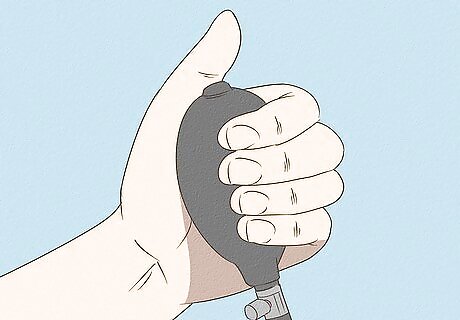
Take the rubber bulb and tighten the valve. The valve needs to be closed completely before you start. This will ensure that no air escapes as you pump, which would produce an inaccurate reading. Twist the valve clockwise, until you feel it stop. It is also important to avoid over-tightening the valve, otherwise you will open it too far and release the air too quickly.
Taking Blood Pressure
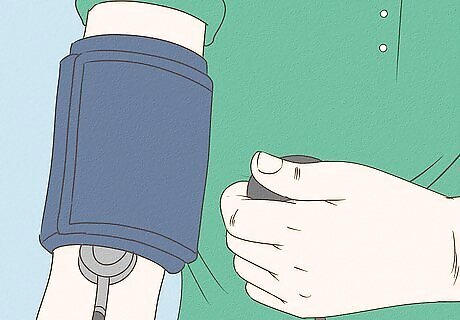
Inflate the cuff. Rapidly pump the bulb to inflate the cuff. Keep pumping until the needle on the gauge reaches 180mmHg. The pressure from the cuff will occlude a large artery in the bicep, temporarily cutting off blood flow. This is why the pressure from the cuff can feel a little uncomfortable or strange.
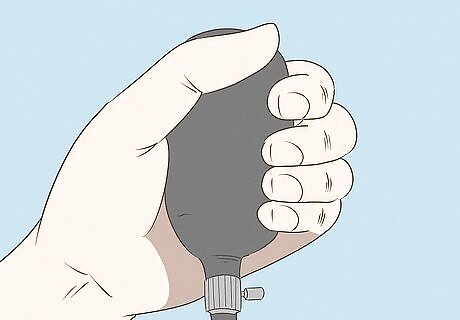
Release the valve. Gently turn the valve on the bulb counter-clockwise, so that the air in the cuff is released steadily, but at a slow pace. Keep an eye on the gauge; for best accuracy, the needle should be moving downwards at a rate of 3mm per second. Releasing the valve while you hold the stethoscope can be a little tricky. Try releasing the valve with the hand on your cuff arm, while holding the stethoscope with your free arm. If there is someone nearby, ask him to assist you. An additional pair of hands can make the process much easier.
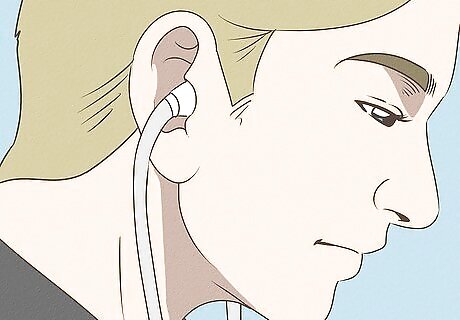
Note your systolic blood pressure. As the pressure drops, use the stethoscope to listen for a thumping or knocking sound. When you hear the first thump, make a note of the pressure on the gauge. This is your systolic blood pressure. The systolic number represents the pressure your blood flow exerts on the walls of an artery after the heart beats or contracts. It is the higher number of the two blood pressure readings, and when blood pressure is written down, it appears at the top. The clinical name for the thumping sounds your hear is "Korotkoff sounds."

Note your diastolic blood pressure. Keep watching the gauge, while using the stethoscope to listen to the thumping noises. Eventually the hard thumping noises will turn into a "whooshing" sound. It is helpful to note this change, as it indicates that you are close to your diastolic blood pressure. As soon as the whooshing noise subsides, and you hear only silence, make a note of the pressure on the gauge. This is your diastolic blood pressure. The diastolic number represents the pressure your blood flow exerts on the walls of an artery when your heart relaxes between contractions. It is the lower number of the two blood pressure readings, and when blood pressure is written down, it appears at the bottom.

Don't worry if you miss a reading. If you miss the exact measure of either number, it's perfectly acceptable to pump the cuff back up a little to catch it. Just don't do it too much (more than twice) as this can affect accuracy. Alternatively, you can switch the cuff to the other arm and repeat the process again.
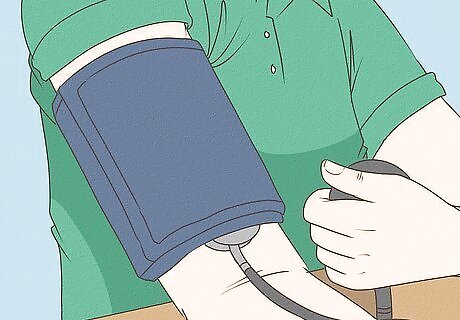
Check your blood pressure again. Blood pressure fluctuates within minutes (sometimes dramatically) so if you take two readings within about a ten-minute period, you can come up with a more accurate average number. For the most accurate results, check your blood pressure a second time, five to ten minutes after the first go. It may also be a good idea to use your other arm for the second reading, especially if your first reading was abnormal.
Interpreting Results

Understand what the readings mean. Once you have recorded your blood pressure, it is important to know what the numbers mean. Use the following guide for reference: Normal blood pressure: Systolic number of less than 120 and diastolic number of less than 80. Prehypertension: Systolic number between 120 and 139, diastolic number between 80 and 89. Stage 1 Hypertension: Systolic number between 140 and 159, diastolic number between 90 and 99. Stage 2 Hypertension: Systolic number higher than 160 and diastolic number higher than 100. Hypertensive Crisis: Systolic number higher than 180 and diastolic number higher than 110.
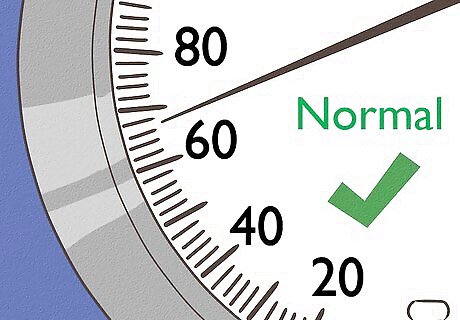
Don't worry if your blood pressure is low. Even if your blood pressure readings are far below the 120/80 "normal" mark, there is usually no cause for concern. A low blood pressure reading of, say, 85/55 mmHg is still considered to be acceptable, as long as no symptoms of low blood pressure are present. However, if you are experiencing symptoms of dizziness, lightheadedness, fainting, trouble concentrating, cold and clammy skin, fast and shallow breathing, dehydration, nausea, blurred vision and/or fatigue, it is advisable that you see a doctor right away, as your low blood pressure may be the result of an underlying condition, which could be serious or cause serious complications..

Know when to seek treatment. It's important to understand that a single high reading does not necessarily mean that you have high blood pressure. It could be the result of many factors. If you take your blood pressure after exercising, after eating salty foods, drinking coffee, smoking, or during a period of high stress, your blood pressure might be uncharacteristically high. If the blood pressure cuff was too loose or too tight on your arm or too large or too small for your size, the readings could be inaccurate. As a result, you shouldn't worry too much about one-off readings, especially if your blood pressure is back to normal the next time you check it. However, if your blood pressure is consistently at or higher than 140/90 mm Hg, you may want to consult with a doctor who can put you on a treatment plan, which usually involves a combination of healthy eating and exercise. Medications may also be considered if lifestyle changes don't help, your blood pressure is very high, or you have risk factors such as diabetes or heart disease. If you get a systolic reading of 180 or higher, or a diastolic reading of 110 or higher, wait a few minutes then check your blood pressure again. If it is still at that level, you need to contact emergency medical services immediately, as you may be suffering from a hypertensive crisis.
















Comments
0 comment